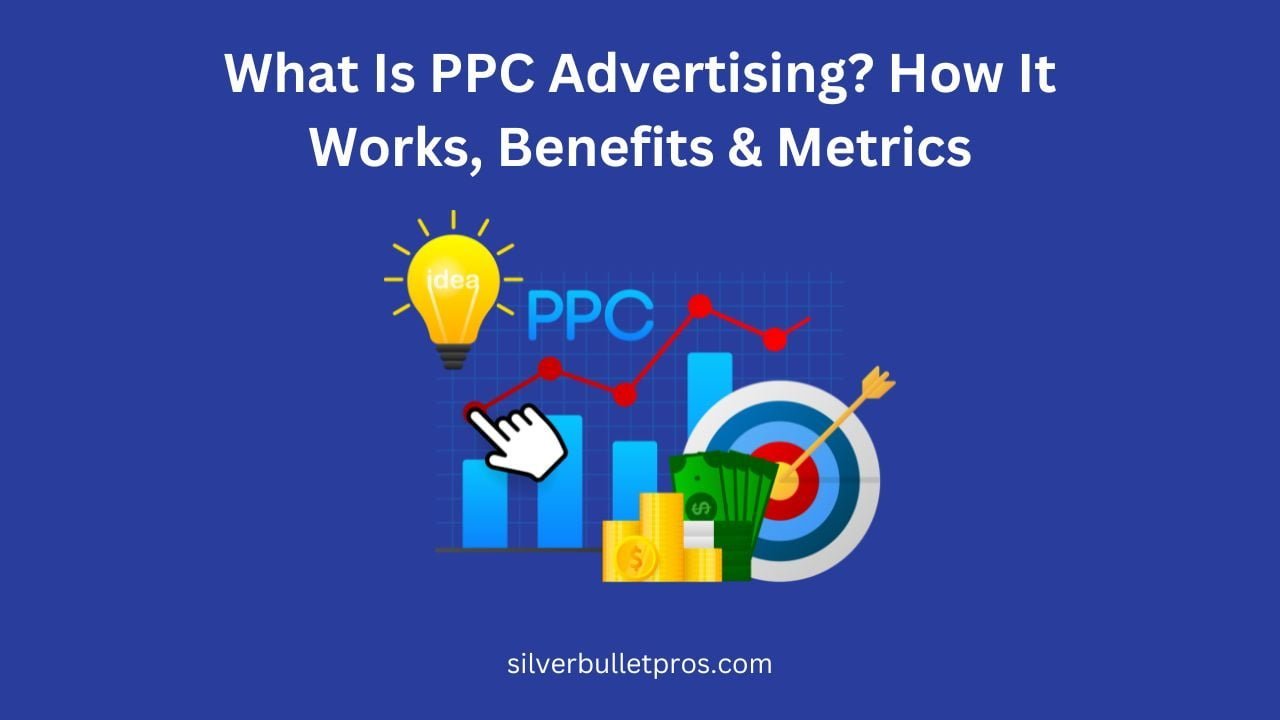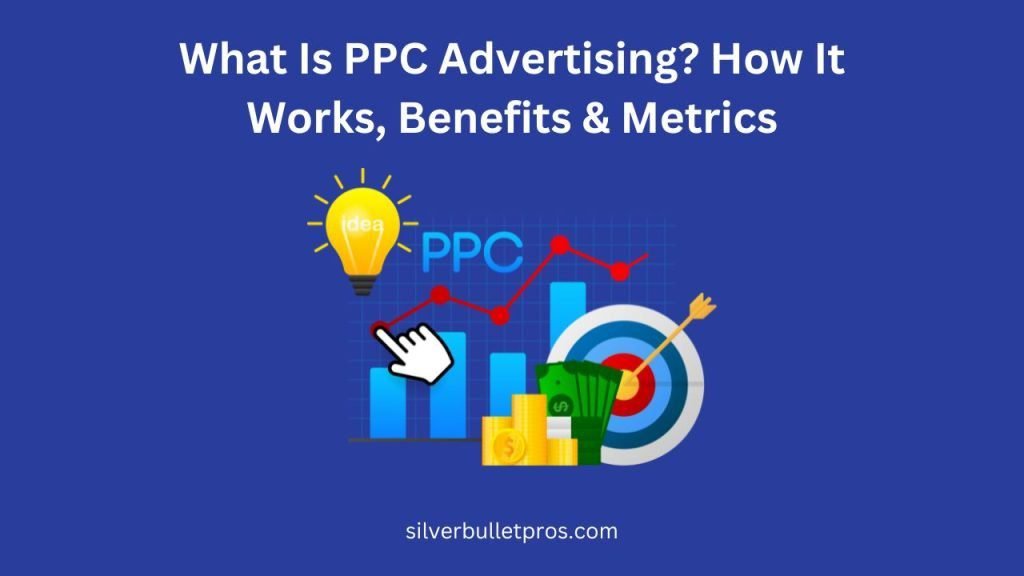

PPC (Pay-Per-Click) advertising is an online advertising model where advertisers pay a fee each time one of their ads is clicked. It's a way of buying visits to your site instead of attempting to earn those visits organically through search engine optimization (SEO). PPC ads appear at the top and bottom of search engine results pages (SERPs) and on websites across the internet.
The most common form of PPC advertising is search engine advertising, like the ads you see at the top and bottom of Google's search results pages. These ads are targeted to match the keywords or queries people enter into the search engine. For example, if you search for “running shoes,” you'll likely see PPC ads for various running shoe brands, stores, and review sites.
How It Works
Here's a simplified overview of how PPC advertising works:
- Choose Keywords: Advertisers select relevant keywords related to their products or services that potential customers might search for.
- Create Ads: They then create text, image, or video ads targeting those keywords. The ads typically appear alongside search results or on relevant websites within the advertiser's network.
- Set Bids: For each keyword, advertisers set a maximum bid – the highest amount they're willing to pay when someone clicks on their ad.
- Auction Process: When a user searches for the keyword, an automated auction takes place to determine which ads will be displayed and in what order based on factors like bid amount, relevance, and ad quality.
- Pay for Clicks: If a user clicks on the advertiser's ad, the advertiser is charged a fee – typically a small amount per click. The amount is determined by the ad auction.
- Track Performance: The advertiser can track the performance of their ads, including costs, click-through rates, conversions, and return on investment (ROI).
Benefits
Cost-Effectiveness
PPC advertising is cost-effective because you only pay when someone clicks on your ad, rather than paying a flat rate regardless of engagement. This makes it an attractive option for businesses of all sizes trying to drive traffic and generate leads or sales.
You only pay when your ad is clicked (pay-per-click model).
With the pay-per-click model, you don't have to pay for ad impressions or views. You only pay when a potential customer is interested enough to click on your ad, making it a very cost-effective way to drive targeted traffic to your website or landing page.
Measurable
PPC campaigns are highly measurable, allowing you to track important metrics like impressions, clicks, conversions, and costs. This data allows you to continuously optimize your campaigns for better performance and higher ROI.
You can track and measure every aspect of your PPC campaign to identify what's working and what's not.
With robust analytics tools, you can gain insights into which keywords, ads, and landing pages are driving the best results. This enables you to make data-driven decisions to refine your campaigns and maximize your return on investment.
Wide Reach
PPC advertising gives you the ability to reach a vast audience across various online platforms and channels. This includes search engines like Google and Bing, as well as millions of websites that display ads through networks like the Google Display Network.
With PPC, you can reach millions of potential customers both within search engines like Google and on millions of other websites.
The extensive reach of PPC advertising allows you to get your message in front of a highly targeted and relevant audience, increasing the chances of driving qualified traffic and conversions.
Global Targeting
PPC platforms offer advanced targeting options, allowing you to selectively display your ads based on various criteria like location, language, device, and user demographics or interests.
You can serve ads globally, or limit your reach based on location, language, or your personas.
This level of targeting ensures that your ads are shown to the most relevant audiences, increasing the likelihood of engagement and conversions while minimizing wasted ad spend.
Boost Brand Awareness
In addition to driving website traffic and conversions, PPC ads can also help to increase brand awareness and recognition. By appearing prominently in search results and across the web, your ads can help to familiarize potential customers with your brand and products or services.
PPC can help you to stand out and boost your brand awareness.
Even if users don't click on your ads initially, repeated exposure can help to build brand recall and consideration for future purchases or interactions.
Mobile Targeting
With the majority of online searches and browsing now happening on mobile devices, PPC advertising provides the ability to specifically target mobile users. This ensures that your ads are visible and optimized for the growing segment of mobile traffic.
You can specifically target mobile device users across multiple search engines and websites because the majority of searches and browsing happens on mobile.
By creating mobile-optimized campaigns and ads, you can improve the user experience and increase the chances of engagement and conversions from mobile users.
Visually Appealing
While text-based ads are common in PPC advertising, many platforms also offer the ability to create visually appealing image and video ads. These types of ads can be more eye-catching and memorable for potential customers.
Visual ads are more eye-catching and memorable for your potential customer.
By incorporating compelling visuals and multimedia elements, you can better capture the attention of your target audience and communicate your brand or product messaging more effectively.
Remarketing
One powerful feature of PPC advertising is remarketing, also known as retargeting. This allows you to display ads to users who have previously visited your website or interacted with your brand in some way.
With PPC, you can follow up with individuals who have previously visited your website.
Remarketing can help to keep your brand top-of-mind and encourage users who have shown interest in the past to revisit your site and potentially convert into customers.
Metrics To Track
To ensure the success of your PPC campaigns, it's essential to track and analyze key metrics. Some of the most important metrics to monitor include:
- Click-Through Rate (CTR): The percentage of people who click on your ad after seeing it. A higher CTR indicates that your ads are relevant and compelling.
- Cost-Per-Click (CPC): The amount you pay each time someone clicks on your ad. Keeping your CPC low while maintaining a high CTR is key to maximizing your ROI.
- Conversion Rate: The percentage of clicks that result in a desired action, such as a purchase, lead submission, or sign-up. This metric helps you understand the effectiveness of your landing pages and sales funnel.
- Cost-Per-Conversion: The total amount you spend on your PPC campaign divided by the number of conversions. This metric allows you to evaluate the overall cost-effectiveness of your campaign.
- Quality Score: A rating assigned by search engines like Google that measures the relevance and quality of your ads and landing pages. A higher quality score can lead to better ad positions and lower costs.
- Impression Share: The percentage of times your ads were shown compared to the total number of times they could have been shown. Monitoring this metric can help you identify opportunities to increase your ad visibility.
By consistently tracking and analyzing these metrics, you can gain valuable insights into the performance of your PPC campaigns and make informed decisions to optimize your strategies for better results.
Tips For Success
While PPC advertising can be a powerful tool for driving targeted traffic and conversions, it's important to follow best practices and strategies to maximize your success. Here are some tips to help you get the most out of your PPC campaigns:
Choose the right keywords.
Keyword selection is crucial in PPC advertising. Conduct thorough keyword research to identify relevant, high-intent keywords that align with your products or services and target audience. Use a combination of broad, phrase, and exact match keywords to capture different stages of the customer journey.
Craft compelling ad copy.
Your ad copy is the first thing potential customers will see, so it needs to be attention-grabbing and compelling. Use persuasive language, highlight unique selling points, and include a clear call-to-action to encourage clicks.
Launch a strong remarketing campaign.
Remarketing allows you to stay top-of-mind with users who have previously interacted with your brand. Set up targeted remarketing campaigns to nurture these warm leads and encourage them to convert.
Conduct regular A/B testing.
Continuously test and refine different elements of your PPC campaigns, such as ad copy, landing pages, and targeting settings. A/B testing can help you identify the most effective combinations and optimize for better performance.
Set a realistic budget.
Determine a reasonable budget for your PPC campaigns based on your goals, industry, and competition. Monitor your spend closely and adjust your bids and budgets as necessary to maintain a healthy return on investment.
What Are Paid Ads?
Paid ads, also known as sponsored ads or paid advertisements, are a form of online advertising where businesses or individuals pay to have their ads displayed on various platforms, such as search engines, social media websites, and other websites or applications